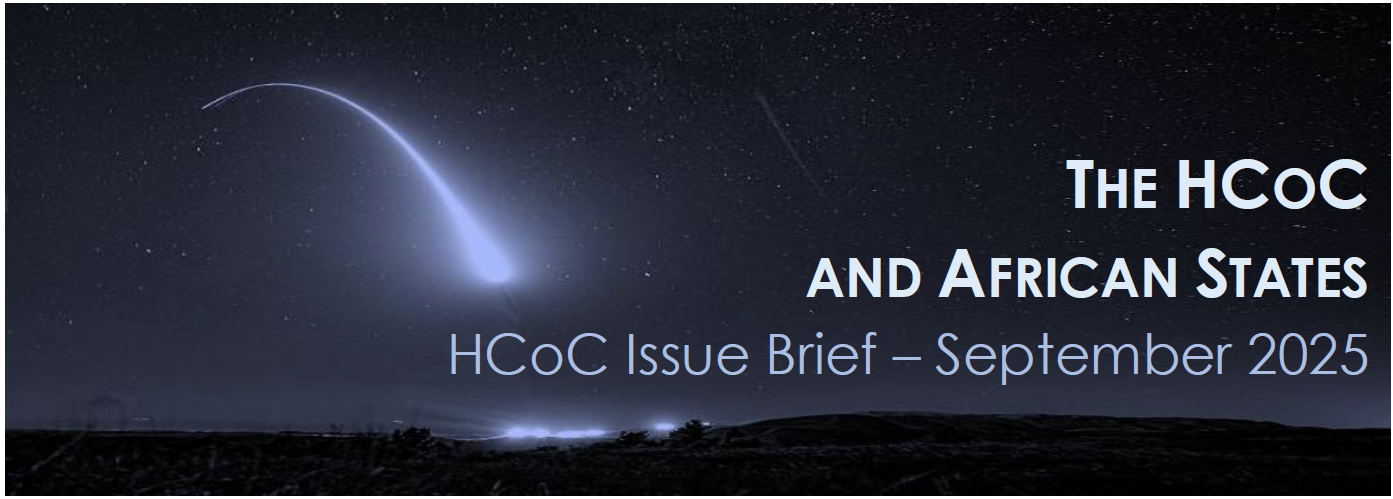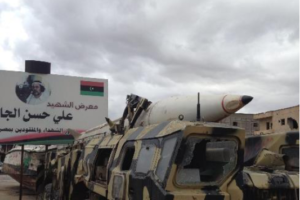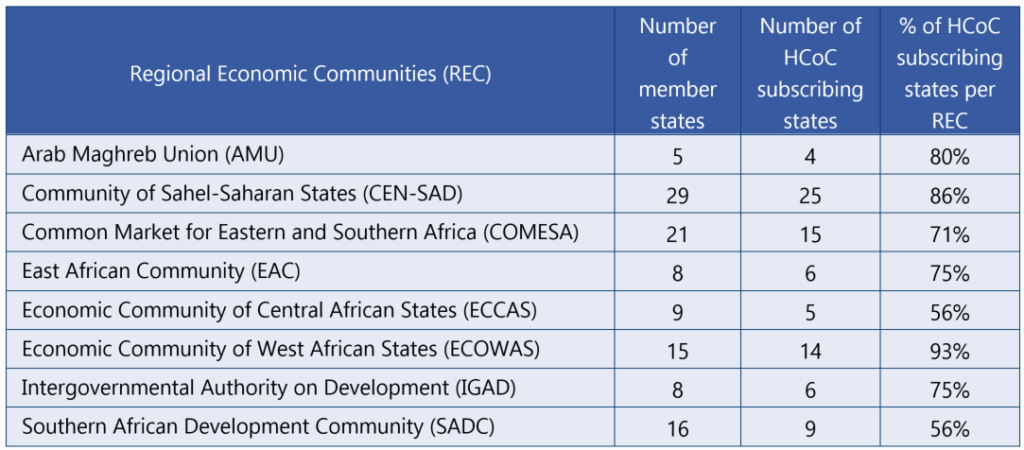
About the HCoC
Adopted in 2002, the Hague Code of Conduct against Ballistic Missile Proliferation (HCoC) is a politically binding instrument aiming to limit the proliferation of weapons of mass destruction (WMDs) delivery vehicles. Composed of a set of transparency and confidence-building measures, the HCoC is the only existing multilateral instrument to focus on WMD delivery vehicles. Signed by 93 states at its inception, the HCoC has now reached 145 subscribing states (as of September 2025).
When subscribing to the HCoC, states commit to abide by a set of UN treaties and international conventions on space security; to submit an annual declaration regarding ballistic missile capacities and national policy on non-proliferation and disarmament treaties and instruments; and to send pre-launch notifications prior to any missile or space launch. Documents are uploaded onto a dedicated online platform (available for subscribing states only) managed by Austria, which acts as the HCoC Immediate Central Contact. Subscription to the HCoC is free of charge.
While subscribing states are asked to exercise ‘maximum restraint’ in the development of ballistic capacities, it should be stressed that they are proscribed neither from possessing ballistic missiles nor from pursuing space launch activities. Subscribing to the HCoC also enables states to gain access to information shared by other subscribing states, and to demonstrate their political commitment to non-proliferation and disarmament.
In brief
In brief
While both ballistic programmes and the risk posed by these systems remain very limited on the African continent, ballistic missiles inherently constitute a global risk – due to their range and destructive potential. Instruments such as the HCoC, which seek to limit the proliferation of such systems, are therefore relevant for African countries.
42 African states have subscribed to the HCoC as of September 2025, and 4 out of the 5 most recent HCoC subscribing states are African: Togo (2019), Equatorial Guinea (2020), Somalia (2020) and Sao Tome and Principe (2023).
The HCoC could hold several benefits for African states, including opportunities for space development: as space capabilities are increasing on the continent, the HCoC could provide a useful and relevant framework.
Authors: Lauriane Héau and Emmanuelle Maitre
History of ballistic activities and programmes in Africa
Very few ballistic programmes have been conducted on the continent, and most of them have since been dismantled:
Egypt1 remains one of the main African states to maintain an operational ballistic program, consolidating its position since the 1950s. The arsenal, initially composed of short-range ballistic missiles such as modernized Scuds and Vector projects, has expanded to include cruise and air defence missiles. The country maintains its non-membership stance toward the Hague Code of Conduct (HCoC) and the Missile Technology Control Regime (MTCR) and has stated that it will not join either of these regimes as long as Israel does not do so.
Libya2 attempted, between 1970 and 2003, with limited success, to develop ballistic capabilities. In 2003, the country abandoned its WMD programmes and joined the HCoC. It destroyed or reduced the range of most of its missiles, including Scud-Bs from North Korea. Nevertheless, some remaining systems were used during the 2011 civil war. Recently, Libya has acquired new Russian air defense systems (S-400, S-300).
South Africa3 developed ballistic capabilities starting in the 1970s, as part of its nuclear program. A successful test launch took place in 1989. However, after the end of the Apartheid regime in the early 1990s, South Africa proceeded to dismantle its ballistic program (alongside its nuclear program). Since then, the country has joined the MTCR and the HCoC
Algeria4 acquired short-range SS-26E/Iskander missiles from Russia in 2017 as part of the modernization of its defense capabilities. These systems are not designed to carry WMDs. They were tested in 2020. Algeria has not joined the HCoC.
Ethiopia,5 which signed the Code in 2002, acquired in 2020 ten Chinese BP-12A missiles delivered. During the conflict in Tigray in 2020, Tigrayan forces seized almost the entire Ethiopian ballistic arsenal, most of which was subsequently destroyed or recovered, leaving the current status of the arsenal uncertain.
Morocco6 finally is also a HCoC signatory state. It decided to procure US MGM-140 ATACMS tactical ballistic missiles, which should be delivered in the coming years.
Ballistic missiles: a threat for Africa
Although the ballistic risk does not appear imminent in Africa and the continent is almost free of WMDs, threats persist, highlighting the importance of African states’ adherence to the HCoC. Ballistic systems have been recently used by both state and non-state actors in Africa (Libya, Ethiopia) and in neighboring regions (Houthis in Yemen), with some circulating illegally via maritime routes. Often insufficient border controls and limited maritime surveillance increase the continent’s vulnerability, exposing it both directly and indirectly to the global consequences of missile and WMD use, with particularly acute effects for states with more precarious economic resources.

HCoC subscription and implementation on the African continent
With 42 subscribing states, 78% of African states have subscribed to the HCoC, which is slightly higher than the world average (75%). While the rate of subscription to the HCoC in Africa has been broadly similar to the global rate of subscription, it is worth noting that 4 out of the 5 most recent HCoC subscribing states are African: Togo (2019), Equatorial Guinea (2020) and Somalia (2020) and Sao Tome and Principe (2023).
African states also broadly support UN General Assembly resolutions in support of the HCoC, with 91% of those that took part in the last vote (A/RES/79/29 in December 2024) approving it.



While subscription rates to the Code is overall improving on the continent, differences exist between sub-regions: 93% of ECOWAS member states and 86% of CEN-SAD member states have subscribed to the HCoC, while only 56% of SADC member states have done so (Figure 4). Finally, the rate of submission of annual declarations remains low across the continent.
HCoC subscription: what benefits for African states?
Committing to additional international security instruments such as the HCoC may face reluctance from some states. Some fear they may have to dedicate scarce resources to issues that are not prominent among their security priorities. Others may be wary of non-proliferation obligations that they perceive as impinging on their right to access to technologies. However, the HCoC is cost-free and requires a very limited administrative burden as states can use a standardised nil form for their annual declaration. In return, it provides an opportunity for African states to gain information shared via the restricted internet platform by other subscribing states on their missiles and launchers policy and on launches, as well as to voice concerns on matters on which they are usually not involved.
The HCoC could also provide benefits in terms of space developments. As well as addressing ballistic missile launches, the HCoC covers space launches, given that the same technologies can be used for both applications (they have a ‘dual-use’ character). The HCoC recognises that ‘states should not be excluded from utilising the benefits of space for peaceful purposes’ but offers a set of principles and a framework for declaring space launches. This can be of particular importance as developments in the field of space have increased in Africa in the past few years. An African Space Agency has been created by the African Union (AU), and many states have already set up national space agencies.7 Several states have built satellites, including Ghana, Nigeria, South Africa, Rwanda, Angola, Morocco, Algeria…, and current trends in space activities show that satellites are getting smaller and cheaper – while becoming more capable. Finally, the potential applications are widespread: better telecommunications and education, crop monitoring, infrastructure management, support in response to natural disasters, etc. While no satellite has been launched from the African continent so far, space launching capabilities are likely to be developed in the mid to long-term, and the HCoC could provide a relevant framework to establish the peaceful nature of these developments.
The HCoC within the arms control, disarmament and non-proliferation regime
Within the global arms control, disarmament and non-proliferation regime, African states have developed some distinct priorities – admittedly with varying levels of implementation:
A priority for Small Arms and Light Weapons (SALW) control. The main regional arms control challenge concerns SALW trafficking, thus efforts have understandably focused on implementing instruments such as the Arms Trade Treaty (ATT), the United Nations Programme of Action to Prevent, Combat and Eradicate the Illicit Trade in Small Arms and Light Weapons in all its Aspects (UN PoA) and (sub-) regional SALW agreements.
A region committed to the elimination of nuclear weapons. 33 African states have already signed the Treaty for the Prohibition of Nuclear Weapons (TPNW); and the African Nuclear-Weapons-Free Zone Treaty (Pelindaba Treaty), currently signed or accessed by 54 states and in force since 2009, prohibits states from conducting research on, developing, manufacturing, stockpiling, acquiring, possessing, or having control over any nuclear explosive device by any means anywhere.
A high-level of commitment in the field of non-proliferation. An Additional Protocol to the IAEA Comprehensive Safeguards Agreement entered into force in 45 states; and 47 have submitted at least one National Report as part of the implementation of UNSC Resolution 1540 (2004) which prevents states from providing any form of support to non-state actors that attempt to develop, acquire, manufacture, possess, transport, transfer or use nuclear, chemical or biological weapons and their means of delivery, in particular for terrorist purposes.
The recognition by many African states that non-proliferation has traditionally gone hand in hand with disarmament and development measures.8
Institutions such as the African Union and the UN Regional Centre for Peace and Disarmament in Africa (UNREC) have been available to assist states with the implementation of the above instruments.
The HCoC therefore appears as a useful instrument to reinforce the non-proliferation and disarmament stance taken by African states. Africa is not exempt from the global threat posed by ballistic systems, nor from proliferation risks. The HCoC could also lead to increased security and development opportunities, notably in the field of space activities. As a result, subscription to the HCoC by African states that have not done so already should be encouraged.
1 Fabian Hinz, ‘After half a century Egypt’s Scuds soldier on,’ Military Balance Blog, IISS, 16 June 2023, https://www.iiss.org/online-analysis/military-balance/2023/06/after-half-a-century-egypts-scuds-soldier-on/.
2 Kazim Abdul, ‘Les forces libyennes lancent des missiles balistiques SCUD dans une nouvelle demonstration de force,’ Military Africa, 25 March 2022, https://www.military.africa/2022/03/libyan-forces-launches-scud-ballistic-missiles-in-renewed-show-of-force/#google_vignette
3 ‘South Africa – Delivery Systems,’ NTI, Last updated: April 2015, <https://www.nti.org/learn/countries/south–africa/delivery–systems/>.
4 ‘Algeria,’ NTI, Last updated: October 2021, <https://www.nti.org/countries/algeria-5/>.
5 SIPRI. (n.d.). Arms transfer database. Stockholm International Peace Research Institute. <https://armstransfers.sipri.org/ArmsTransfer/TransferData>.
6 Joe Saballa, ‘Morocco Buys Long-Range ATACMS Missiles From US,’ The Defense Post, 12 July 2024, https://thedefensepost.com/2024/07/12/morocco-atacms-missiles-us/
7 ‘Statute of the African Space Agency,’ AU, <https://au.int/sites/default/files/treaties/36198–treaty–statute_african_space_agency_e.pdf>. The full list of space agencies in Africa can be found here: <https://africanews.space/list–of–space–agencies–in–africa/>.
8 Nicolas Kasprzyk, Emmanuelle Maitre, Xavier Pasco and Noel Stott, ‘The HCoC: relevance to African states,’ Policy Brief 90, Institute for Security Studies, September 2016.



